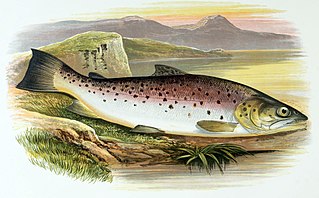 W
WThe island of Great Britain, along with the rest of the archipelago known as the British Isles, has a largely temperate climate. It contains a relatively small fraction of the world's wildlife. The biota was severely diminished in the last Ice Age, and shortly thereafter was separated from the continent by the English Channel's formation. Since then, humans have hunted the most dangerous forms to extinction, though domesticated forms such as the dog and the pig remain. The wild boar has subsequently been reintroduced as a meat animal.
 W
WThe fauna of Scotland is generally typical of the northwest European part of the Palearctic realm, although several of the country's larger mammals were hunted to extinction in historic times and human activity has also led to various species of wildlife being introduced. Scotland's diverse temperate environments support 62 species of wild mammals, including a population of wild cats, important numbers of grey and harbour seals and the most northerly colony of bottlenose dolphins in the world.
 W
WThe island of Great Britain, along with the rest of the archipelago known as the British Isles, has a largely temperate climate. It contains a relatively small fraction of the world's wildlife. The biota was severely diminished in the last Ice Age, and shortly thereafter was separated from the continent by the English Channel's formation. Since then, humans have hunted the most dangerous forms to extinction, though domesticated forms such as the dog and the pig remain. The wild boar has subsequently been reintroduced as a meat animal.
 W
WDictyna latens is a species of spider found in Europe to Central Asia.
 W
WThe Eurasian eagle-owl was not considered to be naturally resident in Britain; however, there is evidence it was native to the UK some time ago. According to a BBC TV programme (2005), a pair bred for several years in a valley in Ministry of Defence land in North Yorkshire. There was some debate as to whether these birds were escapees or whether they have arrived naturally from the continent, which would only be a short journey from either France, the Low Countries or Scandinavia. At the time the program was made, they had reared 20 young to independence, and three young were in the nest. Nothing was known of what happened to those 20 young, except that one of them electrocuted itself on power lines in Shropshire.
 W
WFacelina annulicornis is a species of sea slugs, an aeolid nudibranch, a marine gastropod mollusc in the family Facelinidae.
 W
WThis list of fish in the River Trent is a list of fish species that have been recorded from the River Trent, a major river in England that starts in Staffordshire, flows through the Midlands, and joins the River Ouse to form the Humber Estuary.
 W
WThe greater horseshoe bat is an insectivorous bat of the genus Rhinolophus. Its distribution covers Europe, Northern Africa, Central Asia and Eastern Asia. It is the largest of the horseshoe bats in Europe and is thus easily distinguished from other species. The species is sedentary, typically travelling up to 30 kilometres (19 mi) between the winter and summer roosts, with the longest recorded movement being 180 km (110 mi). The frequencies used by this bat species for echolocation lie between 69–83 kHz, have most energy at 81 kHz and have an average duration of 37.4 ms.
 W
WThis is a list of mammals of Great Britain. The mammal fauna of Great Britain is somewhat impoverished compared to that of Continental Europe due to the short period of time between the last ice age and the flooding of the land bridge between Great Britain and the rest of Europe. Only those land species which crossed before the creation of the English Channel and those introduced by humans exist in Great Britain.
 W
WThis list comprises 231 species of non-marine molluscs that have been recorded in the scientific literature as part of the fauna of the island of Great Britain; this total excludes species found only in hothouses and aquaria. The list includes terrestrial and aquatic gastropods, and aquatic bivalves. Molluscs that are fully marine are not included here, except for two marine pulmonate snails. In other words, this list includes land snails and slugs, and freshwater and brackish water snails. It also includes freshwater mussels and clams, including some that can tolerate brackish water.
 W
WTen or eleven species of reptiles occur in Great Britain: three snakes and three lizards, which were established at the time of the last ice age. Additionally, Britain has a number of introduced species which have become naturalized in their new environments.
 W
WThe small blue is a Palearctic butterfly in the family Lycaenidae. Despite its common name, it is not particularly blue. The male has some bluish suffusion at the base of its upper wings but is mostly dark brown like the female. The species can live in colonies of up to several hundred and in its caterpillar stage is cannibalistic.
 W
WFerox trout is a variety of trout found in oligotrophic lakes/lochs of Ireland, England, Scotland and Wales. Ferox trout is a traditional name for large, piscivorous trout, which in Scotland feed largely on Arctic char. It has been argued to be a distinct species, being reproductively isolated from "normal" brown trout of the same lakes, particularly in Ireland. However, it is uncertain whether the ferox of different lakes are all of a single origin. This fish grows to a length of 80 centimetres (31 in) SL.